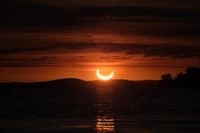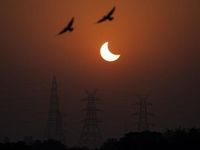On Saturday morning, March 29, 2025, a partial solar eclipse will cast its shadow across parts of the Northern Hemisphere, offering a unique celestial spectacle for eager skywatchers. However, not everyone will be able to witness this astronomical event, particularly those in British Columbia, Canada, who will miss out on the action.
The eclipse will be visible primarily in eastern provinces of Canada, including New Brunswick, Newfoundland and Labrador, and Nova Scotia, where viewers can expect to see the moon partially obscuring the sun. In fact, the extreme northeastern part of the United States, especially areas like the Nunavik region of Quebec, will experience maximum obscuration, with up to 94 percent of the sun covered at its peak.
This partial solar eclipse is set to begin at 5:26 a.m. EDT (9:26 a.m. UTC) and will last until 8:20 a.m. EDT (12:20 p.m. UTC). The maximum eclipse will occur at approximately 6:47 a.m. EDT (10:47 a.m. UTC), when the moon will cover a significant portion of the sun's disc. In Bar Harbor, Maine, for instance, the sun will rise at 6:19 a.m., with the maximum eclipse occurring just three minutes later.
While this eclipse may not offer the dramatic totality witnessed during the “Great American Eclipse” of 2024, it still promises an exciting visual treat. Observers will have the chance to see the sun transformed into a crescent shape, an effect sometimes referred to as the “devil horns” phenomenon. This occurs when the sun rises during the eclipse, creating a striking crescent silhouette against the horizon.
Unfortunately for those on the West Coast, particularly in British Columbia, they will have to wait for a full solar eclipse scheduled for March 3, 2026, which will pass directly over Vancouver. For now, residents can enjoy a live stream of the eclipse provided by Timeanddate.com, starting at 2:30 a.m. PDT (5:30 a.m. EDT), ensuring that even those unable to see it in person can still partake in the experience.
As the eclipse approaches, experts are urging viewers to take necessary precautions to protect their eyes. Looking directly at the sun, even during a partial eclipse, can cause irreversible damage to the retina. The American Astronomical Society (AAS) recommends using solar eclipse glasses that conform to the ISO 12312-2:2015(E) international safety standard. Modern eclipse glasses do not expire, but it’s crucial to ensure they are free from rips or scratches before use.
In addition to the eclipse, skywatchers in Metro Vancouver can look forward to the Lyrids meteor shower, which will be active from April 17 to April 26, 2025. This meteor shower can produce bursts of up to 100 meteors per hour, although typically, observers will see about 10 to 20 meteors per hour during its peak.
As excitement builds for the upcoming partial solar eclipse, it’s essential to remember that the weather may play a significant role in visibility. The forecast for northeastern parts of the United States suggests potential cloud cover, rain, and even snow, which might hinder the viewing experience. In Europe, observers can expect varying levels of obscuration, with most regions seeing only around 20 to 30 percent of the sun covered, except for areas like Ireland, which may see about 40 percent obscuration.
As the eclipse sweeps from eastern Canada to Siberia, it will last around four hours, with the best views expected from northeastern Canada and Greenland. According to Paris Observatory astronomer Florent Deleflie, “The alignment is not perfect enough for the cone of shadow to touch the Earth's surface,” which means that a total eclipse will not occur anywhere on Earth during this event.
For those looking to engage with the eclipse more interactively, local astronomy observation centers may offer safe viewing opportunities, complete with expert guidance on celestial mechanics and sunspot observations. Alternatively, a simple pinhole projector can be crafted by poking a small hole in a piece of paper or cardboard, allowing sunlight to pass through and create an inverted image of the eclipsed sun on the ground.
As the world gears up for this partial solar eclipse, it is a reminder of the wonders of our universe and the celestial events that connect us all. Whether you’re in the path of maximum obscuration or watching from afar, the eclipse is sure to inspire awe and curiosity about the cosmos.
Looking ahead, a greater spectacle awaits on August 12, 2026, when a total solar eclipse will be visible in Iceland, northern Spain, and parts of Portugal, with more than 90 percent of the sun obscured in areas of Europe including Britain, France, and Italy. This will mark the first total solar eclipse since one swept across North America in April 2024, making it an event not to be missed.





